If you are not a rock climber, you may not hear of top-rope and may wonder what is top-rope climbing? It is a type of climbing that passes a rope through an anchor system at the top of the climb. A climber is securely attached to one end of the rope and a belayer ties to the other end of the rope at the foot of the climb. The belayer belays the climber to the top. In general, top-rope climbing is safer and psychologically and physically less demanding than lead climbing or bouldering.
You can top-rope climbing outdoor or indoor. I was introduced to top roping in an indoor rock climbing gym. If you are a first-time climber and do not have friends who can be your guides to climbing outdoor, I would recommend trying out rock climbing in an indoor climbing facility first.
Top Rope Climbing Indoor
Learning top-roping in an indoor facility is the simplest and cheapest route for a beginning climber like me when I started.
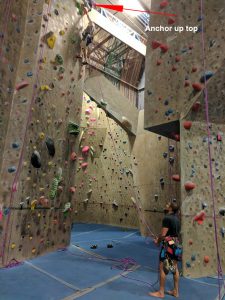
A rock gym has all the equipment and artificial rocks for us to climb safely. We provide our own personal equipment such as climbing shoes, harness, belay device with a carabiner, and possibly our own rope for lead climbing. The gym provides rope for top-roping.
For top-roping indoor, the anchor is usually a tubular pipe located at the top of the climb. Different gyms have different preferences on how the rope is looped around a pipe. The rope can be looped twice around the pipe or once around the pipe. I have been to climbing gyms that use chains to loop once around the pipe. Each one of these techniques affects differently with the belaying.
Single Loop
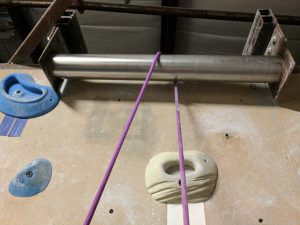
For a single loop top-roping, the belayer should be on extra alert. If the climber is heavier than the belayer and when the climber falls, the belayer will be pulled up off the ground while catching the climber’s fall. To resolve this issue, the gym usually provides an extra 50 pound weighted sandbag to anchor the belayer to the ground.
The single loop will not slow down the fall as much as a double loop because there is less friction. There are two advantages with a single loop:
- The rope wears out slower than a double loop.
- It is easier to lower kids with a lightweight down to the ground.
Double Loop

For a double loop top-roping, there is more friction to the rope so when a climber falls the belayer is not pulled up off the ground. Personally, I prefer the double loop top-roping method. I am usually the lighter belayer and my climber is my husband so the double loop helps keep my feet on the ground when I belay. It is also much more forgiving for a new belayer. The gym we climb at has the double loop method.
On the negative side, the rope wears out quicker than the single loop and it is harder to lower little kids lighter than 30 pounds. For lighter climber, it feels like the belayer needs to push the rope through the belay device in order to lower the climber.
Chain Loop
Some gyms use a short chain loop around the pipe once. The rope is then looped through the ends of the chain. The chain creates more friction than a single loop but still less friction than the double loop. I still need the extra 50-pound sandbag to weigh me down while belaying a heavier climber. I do not know much about the wear and tear of the rope using this method.
Outdoor Top Rope
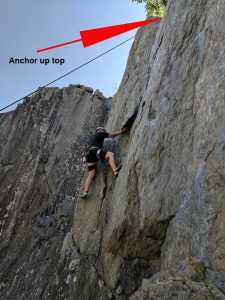
Top roping outdoor is also a lot of fun. However, it is helpful that you are top-roping with a class, a guide, or with a friend who is an experienced outdoor climber. There are a lot more setup and equipment involved. You will also have to deal with nature and the weather such as rain.
Top roping anchor for outdoor can be a tree, a solid rock, or a crack using a cam for trad climbing (this is another climbing technique).
In general for outdoor, top roping is often recommended for certain area because it cannot be lead climbed for various reasons such as unsafe or environmentally damaging. For an example, we visited Great Falls in Virginia located in the DC and surrounding areas. This area is common used for top-roping. There are also lots of cracks so there are trad climbing available which can be lead climbed. Lead climbing safely at Great Falls is a debatable topic among the climbing community. In my opinion, if there are any doubts, I would top rope instead of lead.
Top Roping Indoor vs Outdoor
I love doing both top-roping indoor and outdoor. Each location has its advantages and disadvantages. When perfect condition exists for outdoor climbing such as good weather, good climbing location, excellent equipment, and a fantastic partner, I would choose climbing outdoor. I love to feel the texture of the rocks and the freedom to choose where my next hold would be. Even though the artificial rocks are built to mimic the real rocks they still are not the same. We are in the open with fresh air and the slight breeze blowing against my hair as I ascend to the top. The slight breeze does not happen all the time, especially during hot and humid weather. However, I love being outdoor. Every time I come back from a climbing road trip, I build more confidence.
On the other hand, I can climb indoors at any time when the gym is opened. I live pretty close to a climbing gym so I can climb as often as I like on my own schedule regardless of the weather. I do not have the same luxury climbing outdoor. When we climb outdoor, we would need at least a 3-day weekend road trip to make it worth while. Our climbing road trip does not happen as often as I would like.
Advantage Outdoor Climbing
- higher learning curve
- build confidence
- fresh air
- real rocks experience
- road trips – travel (I love to travel and road trips)
Disadvantage Outdoor Climbing
- weather
- nature — critters & poison ivy
- rough rocks and come home with scratches and bruises
- carry around heavy equipment and can be expensive
- far way – takes time
Advantage Indoor Climbing
- anytime (no worries about the weather)
- near home
- no need for heavy equipment
Disadvantage Indoor Climbing
- can get boring
- artificial rocks
In conclusion, I practice in building strength and technique with my regular climbs at the gym and plan climbing road trips twice or three times a year to apply the technique that I have been practicing. I can have the best of both worlds.
I hope this article help with your understand regarding rock climbing a little bit more. Please feel free to drop me a note on your thoughts below.




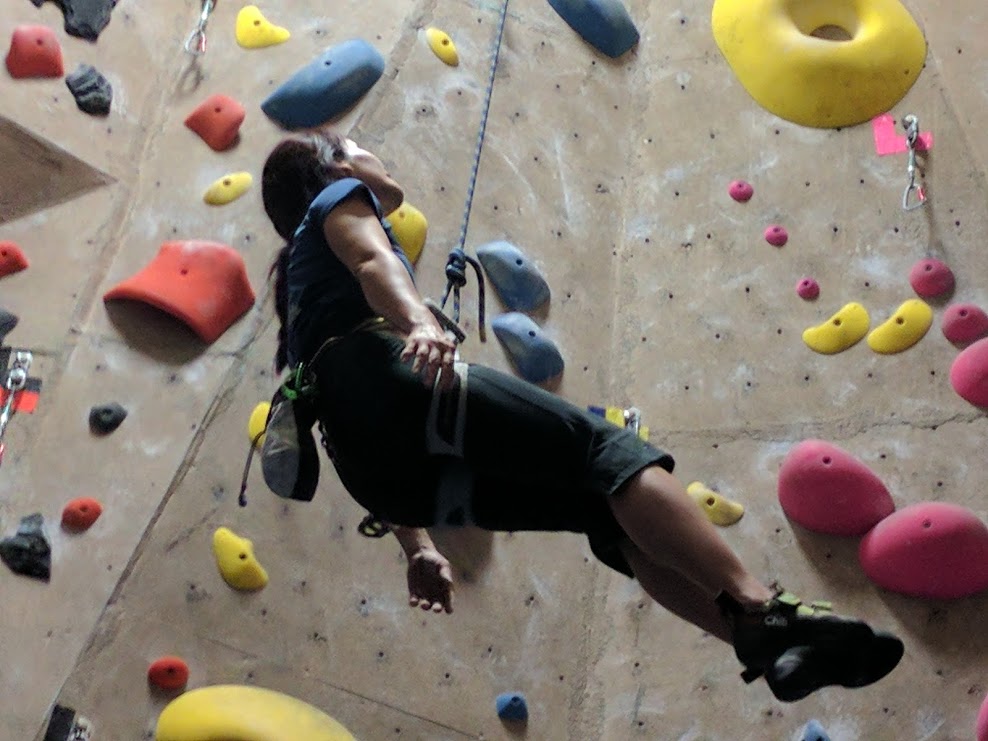
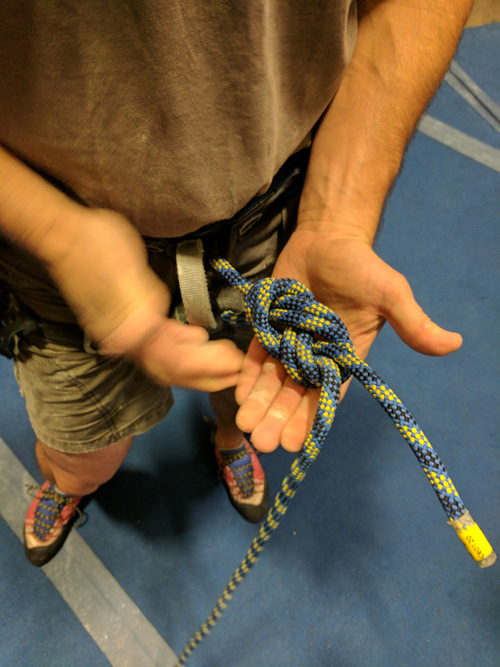
2 thoughts on “What is Top Rope Climbing – Indoor vs Outdoor”
Thanks for this post! I used to be an avid rock climber back in high school. Its a great workout and mental challenge. I never was any good at it, but I never let that stop me!
I have always wanted to try outdoor rock climbing but I unfortunately never had the time, (or courage) to follow this through with proper road trip planning. Your outline of the pros and cons of outdoor climbing has helped me see that it is really something I want to do, and I should be better about making it happen.
Cheers!
Thank you for sharing your thoughts. I am glad you had a chance to try it out. You were much more adventurous then me during my high school years. Outdoor climbing is super fun. It’s much more intense because just being outdoor. Definitely have a guide to help you out for your first few trips. You’ll have more fun and build more confidence. If you are very in Orlando, drop me a note via email. We can climb together…